The Lensbaby 3G creative zonal focus tilt-swing lens
THE LENSBABY was a novelty item when first introduced as a low-cost meniscus lens mounted on a flexible concertina tube with an SLR mount-fitting at the other end. Like the Diana or Holga cameras sometimes used by professionals to capture a feel of post-modern grunge, it used aberrations creatively.

Since then it has gone through two revisions, increasing in price and complexity as well as quality. The third generation uses a low dispersion multi-coated glass achromatic doublet lens, introduced with Lensbaby 2, but adds precision control of three points of tilt and swing on threaded posts plus a fine-focus stage in a helical thread.

The clever part is the unlock and lock system which grabs all three screw-gear posts simultaneously. Just squeeze the Baby’s balls together, and it releases grip instantly allowing:
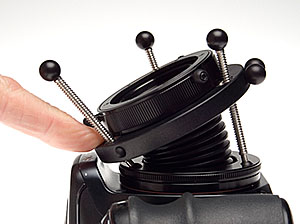
Fingertip adjustment if the camera is being held in both hands (use two fingertips either side to rock the lens angle and press it back for focus).
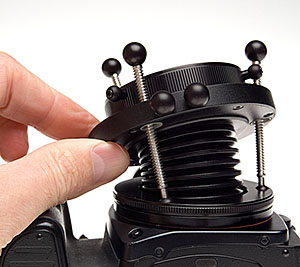
More control with finger and thumb. This is your start point, rough setting, of both focus and skew. It helps to be looking through the finder when doing this.
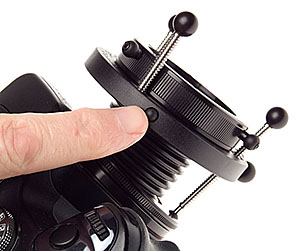
Lightly depress a small button located perfectly for your shutter finger, and the setting is locked. You can usually bring another finger over to do this while two are holding the lens position. It’s rather like playing the ocarina, but not many people play ocarina these days.
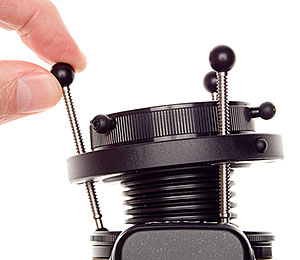
Then, fine tune the skew with the three screw posts (with black ball knobs on their ends).
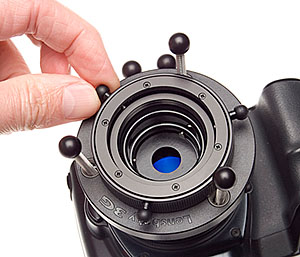
Finally, hone the focus using the focus collar which has three lugs to make handling easier.
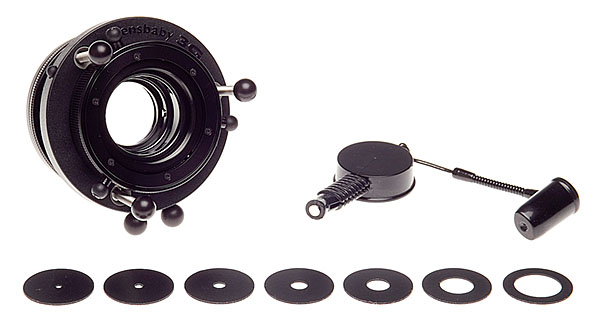
The aperture system is unusual. Small magnetic plastic rings drop into the lens front, and are held firmly by a set of three spring-loaded ball bearings which the ring pops behind. To remove or insert the ring, a probe with a magnetic tip is supplied. It works perfectly. This probe has a small tub on its other end, neatly re-purposing a Kodak film can lid as its cap, to hold the unused aperture discs. It also has a pen-top cap for the probe end to prevent its very limited magnetic field getting anywhere near sensitive components.
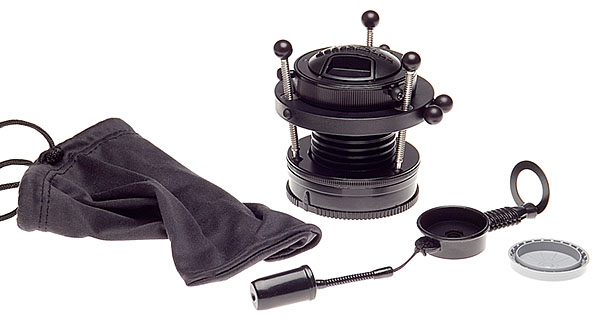
It comes with a good quality rear mount cap properly labelled for the Lensbaby but custom made for M-AF/KM/Alpha, and a good clip-in front lens cap, and a soft pouch. Great to see an independent maker offering full support for the Alpha system with such an unusual product, rather than ignoring the minority and only going for the lowest common denominator brands!
The maximum effects of the Lensbaby 3G are obtained on full frame cameras, but we tested it on an APS-C format using the Sony Alpha 100. It is also sold for 4/3rds format, which will be even more challenging. Some camera systems use a near-60mm lens type, but Alpha uses a 50mm version, which is better all-round. Maybe one day I’ll be able to follow up with a test on the full frame Alpha…

The outer zone of the image field has the most aberration, distortion and vignetting to exploit for effect and much of this is lost in theory on the small digital format. Enough remains within the 15.8 x 23.6mm sensor view (above) to be exploited, generally using wider apertures – full aperture of f/2 was used for the existing light snapshot above which makes a shopping mall and chainstore anonymous though our shoppers remain sharp.
Here the Lensbaby shows a weakness, which can only be solved easily by taping some ND gel filter to a wide aperture, or obtaining an ND4, 8 or 16 filter to fit the (undocumented) 37mm filter thread. Studio flash shots at f/11 or f/16 – pretty much what my 300/300/600 Elinchrom rig demands at minimum power for small still life – show almost no typical Lensbaby effects can actually come out sharper than many premium grade prime or zoom lenses, even at full bore!
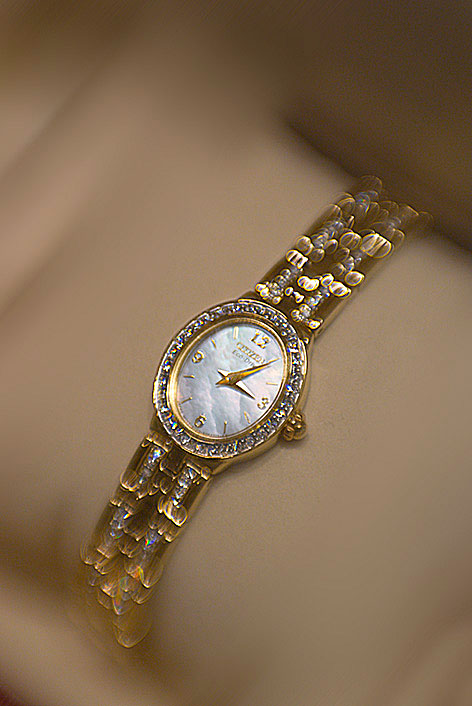
You must work atf/2 to f/4 for maximum visible special effects. Even this is at f/2 – wide open. How about sharpness, shooting through a jewellery shop cabinet at such a wide aperture, hand held, visually focused on the Sony Alpha standard focusing screen? Here’s a 100 per cent section of the shot above:
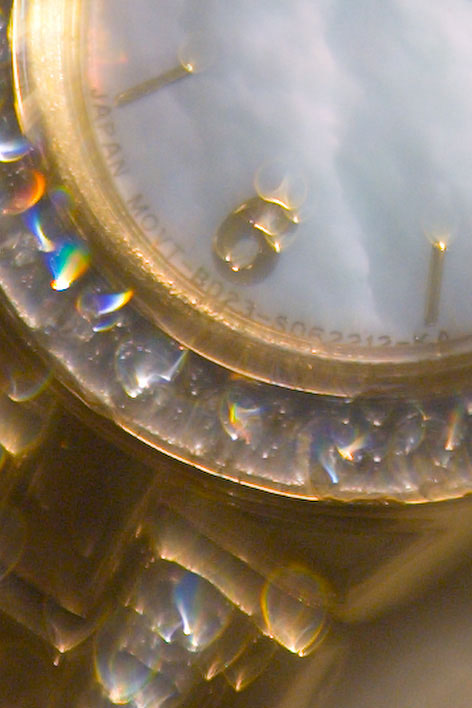
As you can see, there are complex and attractive effects from the aberrations and the tilt/swing, but the core image as shown by the lettering on this tiny ladies’ watch is pin-sharp under the mushy glow.

Here’s another example from the same set of quick snaps. This can blow up to 20 x 16″ and still look great. You can get soft focus using Photoshop but you just can’t get the complex blend of optical effects present in this shot.
At f/5.6, the lens begins to appear rather sharp across its entire field. From f/8 to f/22, you can actually use it as a good quality tilt-swing lens with a fixed degree of rise, cross or fall (it’s all one action). Instead of narrow planes of sharp focus intersecting an image unexpectedly you can get traditional large format style focus in depth. Just set the shot up wider open (the f/2.8 aperture is better for focusing than completely naked f/2), insert the f/11 of f/16 aperture disc, and you’ll be very surprised by the sharpness and lack of chromatic fringes. With digital SLRs you lose some sharpness at apertures smaller than f/11 because of diffraction.

This is not why Lensbaby 3G is bought. Most users will take it into the wide world, using it for fashion, stock, still life or architectural interpretations. They will work with f/2, f/2.8 or f/4 and tilt the lens plane to create a vortex of sharpness with dramatic blur streaming out from it. Atf/4 the shot above uses the lens swung to put the plane of focus through the stamen tips and the petal edge, and blur the further part of the flower more.
The instructions for Lensbaby remind you to be very careful with your digital SLR’s dioptric viewfinder correction. They do not tell you why. Most DSLRs are poor for manual focusing as they don’t have old-style ground-glass screens, they have extra bright versions which are nearly transparent. This makes it possible for the eye, if misfocused by the eyepiece, to see unfocused images as sharp. It may be worth getting a matt screen when someone like Haoda makes a plain one. Focusing the Lensbaby with the split-image/microprism Haoda screen is not so easy.
There is a secondary effect of this which Lensbaby do not mention; these screens don’t give an accurate preview of depth of field. This applies to nearly all modern SLRs. You will see more depth of field than you actually get. The results from Lensbaby may surprise you by appearing more extreme in the final image than you set up for, so it is best to make tests before using the lens on a non-repeatable commission.
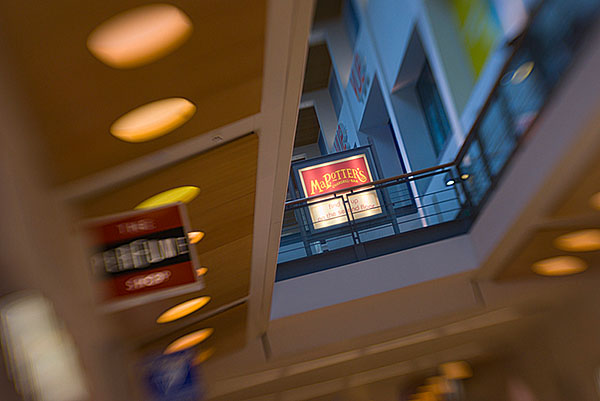
It’s worth doing some imaginary assignments. Say this was a shot for an illuminated sign supplier. They would want their sign sharp.
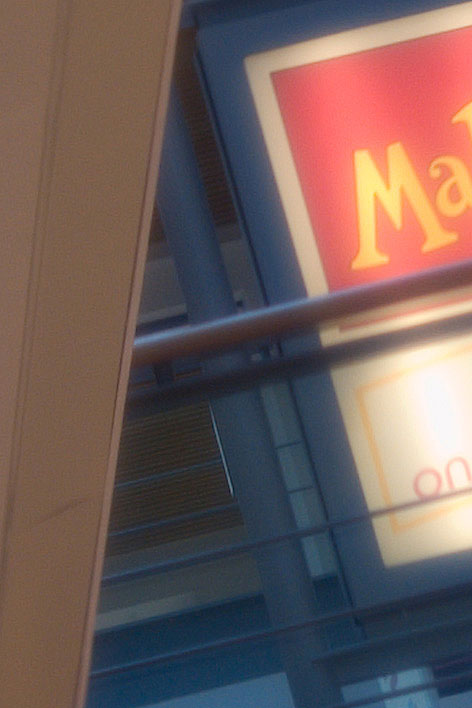
Full f/2 aperture might be right for the effect, but you can see here that a small focusing error has made the sign a little less sharp than the detail in the background. You would, if you did some tests like this, decide that with Lensbaby it’s necessary to take many different shots, tweaking the focus or the swing/tilt screws a tiny amount, maybe fitting different apertures. You just can’t rely on a single shot with visual focus preview via a DSLR focus screen. This is at 100 per cent, equal to an A2 print at screen resolution, but that’s how picture get examined these days.
Should it be used for weddings or portraits? Difficult question. Unlike Photoshop effects applied later on, Lensbaby blur is indelibly written into your capture. What is needed for the future is a Lensbaby Plug-In or filter suite for Photoshop which copies the results from this £175+VAT specialised optic for jobs where you just can not afford to sacrifice the original shot to pure effect.
As for value for money, my initial thought was that it was too expensive – you can get a complex zoom for the same. Then I remembered the old Rodenstock Imagon. Really, it was not so very different optically and you paid £600 when £600 was real money for this with a focusing tube and few aperture discs.
Creative apertures
Now why Lensbaby currently only supplies plain aperture discs with the lens I have no idea, as for a very small outlay you get a kit of creative aperture shapes such as star and heart or slot, and cut-your-own blanks – a mere $9.95 kit, trivial compared with the cost of the lens which is more than many popular wide range zooms. Imagon-style perforated, patterned aperture discs would make it wonderful for soft focus portraits and zany shaped apertures – like f/11 hearts, stars, slits, asterisks, triangles and so on – could create brilliant bokeh effects. Of course you can make your own from black paper but it’s not magnetic, and you would have real trouble drilling the multiple holes for a classic soft-focus lens diaphragm. A leather punch can be used with the magnetic material blanks.


Two examples using the star-shaped Creative Aperture (added Dec 2008 revision)
They could also make a pinhole aperture and some high definition f/11-f/22 apertures with precision foil edges to the hole, reducing the diffraction issue. The existing apertures are not very precisely cut and the material is very thick by iris diaphragm or Waterhouse stop standards.
So, Lensbaby 3G has plenty of potential for add-on accessory modules or DIY custom apertures. Overall, the clever functionality of the mount makes it worth the money. For further UK regional information, visit www.intro2020.co.uk. For international information, see Lensbabies.com
Update: new LensBaby models (Control Freak, Muse and Composer) have been introduced in December 2008. They have interchangeable lens units, offering a choice of plastic or glass optics, and refined designs. Wide, tele and close up adaptors are also available. The Control Freak is the new 3G update.
– David Kilpatrick
All photographs © David Kilpatrick/Icon Publications Ltd may not be reproduced or copied without express permission. Studio photographs taken on Konica Minolta 7D with 28-105mm Sigma HS UC III zoom, Elinchrom flash, and Tre-D light table. Even at the lowest power on the two 300 and one 600 Ws heads the aperture was f/14. This is also the set-up I use for stock image table top objects. Lensbaby could only reasonably be used with a tripod and the modelling lights as the source.
Specifications
- 50mm coated achromatic glass doublet.
- Three-post tilt/swing and focus from under 30cm to beyond infinity plus fine focus thread.
- Waterhouse Stops: f/2 (no disc), f/2.8, f/4, f/5.6, f/8, f/11, f/16, f/22.
- Size: 76mm h x 90mm w.
- Filter Thread 37mm (undocumented).
- Weight 161.59g.
- Manual fixed (not T) mounts with rear cap for Canon EF (EOS), Nikon F, Minolta-Sony A, Pentax K, 4/3rds system, Leica R.
- Automatic exposure possible in aperture priority mode for most digital and film SLR camera bodies; a fixed correction may be needed. Some Nikon models allow manual exposure only.
